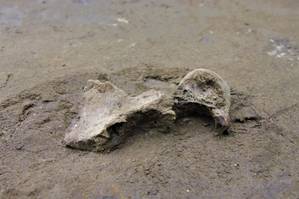 |
| 1/5. Ilustración del Homotherium latidens. (Imagen: © Mauricio Antón) |
Tras el hallazgo de los restos de un tigre Dientes de Sable en el yacimiento arqueológico de Schöningen en Alemania, un largo examen de los fragmentos del cráneo en la Universidad de Leiden en los Países Bajos puso de manifiesto que el animal era un ejemplar de la variedad europea del tigre Dientes de Sable, llamada Homotherium latidens. El reciente descubrimiento constituye el tercer ejemplo de este gran felino depredador procedente de Schöningen.
El hallazgo de los restos lo hizo el equipo de Jordi Serangeli, de la Universidad de Tubinga en Alemania.
Largas garras, colmillos afiladísimos y curvados, y el tamaño corporal de un león adulto: esta especie de tigre Dientes de Sable (Homotherium latidens) era un serio competidor en la caza, así como un peligroso depredador, para los humanos de su época. [...] Noticias de la Ciencia y la Tecnología
Successful Dig Reveals an Almost Complete Skull of a Saber-toothed Cat | University Tübingen / Link 2
 |
| 2/5. In-situ position of a skull fragment from the third Homotherium, which was discovered on 25 May 2015 at the archeological dig in Schöningen. © Univ. Tübingen / Senckenberg |
A third individual saber-toothed cat was discovered in Schöningen
Research Institute and the University of Tübingen, the excavation team found the remains of a saber-toothed cat at the archeological site in Schöningen. An examination of the skull fragments at the Dutch University of Leiden revealed the animal to be a representative of the European saber-toothed cat, Homotherium latidens. The recent discovery constitutes the third example of this large predatory cat from Schöningen.
Long claws, razor-sharp, curved canine teeth and the size of a fully grown lion: the saber-toothed cat (Homotherium latidens) was a competitor as well as a dangerous predator that even posed a risk to the humans of its time. “In the course of our excavation in May 2015, we came across conspicuous bone fragments,” explains Dr. Jordi Serangeli, a scientist at the University of Tübingen and the excavation leader at the approximately 300,000-year-old archeological site, and he continues, “In total, there are three individuals of Homotherium present in these relatively young sediment layers.”
Until the first discovery of a saber-toothed cat in 2012 at the Schöningen excavation site in Lower Saxony it had been assumed that the large cats were already extinct about 200,000 years earlier, i.e., around 500,000 years ago. “Our findings show that 300,000 years ago, the saber-toothed cats were not as rare as previously thought,” adds Serangeli.
During a restoration in 2016, André Ramcharan and Ivo Verheijen at the University of Leiden were able to reassemble the eleven bone fragments into an almost complete neurocranium...







No hay comentarios:
Publicar un comentario